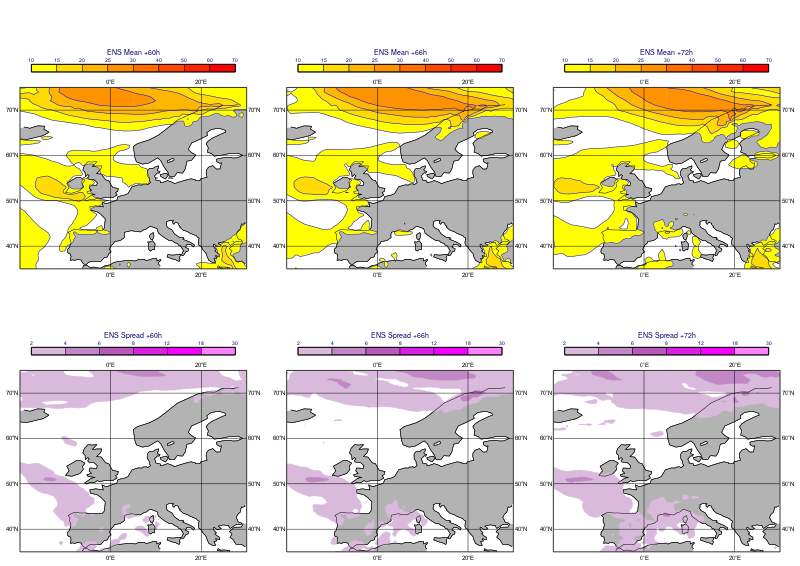Computing ensemble mean and spread with xarray and plotting the results with Metview
 In this example we will compute and plot the ensemble mean and spread (standard deviation) for multiple steps of ECMWF forecast fields stored in GRIB format. We will use a combination of Metview and xarray to achieve this goal.
In this example we will compute and plot the ensemble mean and spread (standard deviation) for multiple steps of ECMWF forecast fields stored in GRIB format. We will use a combination of Metview and xarray to achieve this goal.
[11]:
import metview as mv
import xarray as xr
File wgust_ens.grib contains ECMWF ensemble forecast retrieved from MARS for 10m windgust with 50 perturbed members and 3 timesteps. We read this data into a Fieldset which is Metview’s own class to handle GRIB data. Alternatively, if you have access to it, these fields can be retrieved directly from MARS by enabling the “retrieve” branch in the code below.
[12]:
usemars = False
if usemars:
fs = mv.retrieve(type="pf", stream = "ef", param = "10fg6", levtype = "sfc",
number = [1,"TO",50], step = [54,60,60], area = [35,-20,75,30], grid =[1,1])
else:
filename = "wgust_ens_nb.grib"
if mv.exist(filename):
fs = mv.read(filename)
else:
fs = mv.gallery.load_dataset(filename)
We will compute the mean and spread for each timestep using xarray. First, we need to tell xarray to keep the variable attributes throughout the computations (available from xarray version 0.11.0).
[13]:
xr.set_options(keep_attrs=True)
[13]:
<xarray.core.options.set_options at 0x7fef9b0086d8>
Then, we load our fieldset into an xarray dataset.
[14]:
ds = fs.to_dataset()
ds
[14]:
<xarray.Dataset>
Dimensions: (latitude: 41, longitude: 51, number: 50, step: 3)
Coordinates:
* number (number) int64 1 2 3 4 5 6 7 8 9 ... 42 43 44 45 46 47 48 49 50
time datetime64[ns] ...
* step (step) timedelta64[ns] 2 days 12:00:00 2 days 18:00:00 3 days
surface int64 ...
* latitude (latitude) float64 75.0 74.0 73.0 72.0 ... 38.0 37.0 36.0 35.0
* longitude (longitude) float64 -20.0 -19.0 -18.0 -17.0 ... 28.0 29.0 30.0
valid_time datetime64[ns] ...
Data variables:
p10fg6 (number, step, latitude, longitude) float32 ...
Attributes:
GRIB_edition: 1
GRIB_centre: ecmf
GRIB_centreDescription: European Centre for Medium-Range Weather Forecasts
GRIB_subCentre: 0
history: GRIB to CDM+CF via cfgrib-0.9.4.1/ecCodes-2.9.0 ...
The computation of the ensemble mean and spread for each timestep can be done by simply aggregating along the number (i.e. the ensemble) dimension of the dataset.
[15]:
ds_mean = ds.mean(dim='number')
ds_spread = ds.std(dim='number')
ds_spread
[15]:
<xarray.Dataset>
Dimensions: (latitude: 41, longitude: 51, step: 3)
Coordinates:
time datetime64[ns] ...
* step (step) timedelta64[ns] 2 days 12:00:00 2 days 18:00:00 3 days
surface int64 ...
* latitude (latitude) float64 75.0 74.0 73.0 72.0 ... 38.0 37.0 36.0 35.0
* longitude (longitude) float64 -20.0 -19.0 -18.0 -17.0 ... 28.0 29.0 30.0
valid_time datetime64[ns] ...
Data variables:
p10fg6 (step, latitude, longitude) float32 1.891894 ... 1.5685972
Attributes:
GRIB_edition: 1
GRIB_centre: ecmf
GRIB_centreDescription: European Centre for Medium-Range Weather Forecasts
GRIB_subCentre: 0
history: GRIB to CDM+CF via cfgrib-0.9.4.1/ecCodes-2.9.0 ...
Having produced these datasets we will plot them with Metview so we convert back our results into fieldsets (i.e. into GRIB).
[6]:
fs_mean = mv.dataset_to_fieldset(ds_mean, no_warn = True)
fs_spread = mv.dataset_to_fieldset(ds_spread, no_warn = True)
To plot our data, we need to tell Metview to send the graphical output to Jupyter.
[7]:
mv.setoutput('jupyter')
First, we define a map area and a 2x3 plot layout to render each field into a separate map.
[8]:
area_view = mv.geoview(
map_area_definition = 'corners',
area = [35,-20,75,30],
coastlines = mv.mcoast(
map_coastline_land_shade = "on",
map_coastline_land_shade_colour = "grey"
)
)
dw = mv.plot_superpage(pages = mv.mvl_regular_layout(area_view,3,2,1,1))
Next, we define the contouring settings using predefined styles and also provide custom titles with automatic extraction of the actual forecast step from GRIB header.
[9]:
cont_spread = mv.mcont(legend= "on",
contour_automatics_settings = "style_name",
contour_style_name = "sh_blu_f02t30")
cont_mean = mv.mcont(legend= "on",
contour_automatics_settings = "style_name",
contour_style_name = "sh_red_f10t70lst")
title_mean = mv.mtext(text_line_1 = "ENS Mean +<grib_info key='step'/>h")
title_spread = mv.mtext(text_line_1 = "ENS Spread +<grib_info key='step'/>h")
Finally, we plot the mean fields into the top row and the spread fields into the bottom row of our layout.
[10]:
mv.plot(dw[0], fs_mean[0], cont_mean, title_mean,
dw[1], fs_mean[1], cont_mean, title_mean,
dw[2], fs_mean[2], cont_mean, title_mean,
dw[3], fs_spread[0], cont_spread, title_spread,
dw[4], fs_spread[1], cont_spread, title_spread,
dw[5], fs_spread[2], cont_spread, title_spread)
[10]:

[ ]: